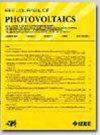Fabrication of g-C3N4-Co3O4/TiO2 Composite Nanofiber Layers by Electrospinning for Indoor Dye-Sensitized Solar Cell Photoanodes
IF 2.6
3区 工程技术
Q3 ENERGY & FUELS
引用次数: 0
Abstract
Nanofibers are a promising 1-D nanomaterial with significant potential to enhance the photovoltaic performance of dye-sensitized solar cells. The heterojunction composite material of g-C3N4 and Co3O4 (CN-Co3O4) is believed to improve electron transport. In this study, electrospinning technology was employed to incorporate a small amount of CN-Co3O4 into TiO2 nanofibers, forming composite nanofibers that serve as an additional layer for the photoanode. Photovoltaic performance measurements confirm that CN-Co3O4/TiO2 nanofibers enhance electron transfer capability and increase the utilization of incident light. Under AM1.5G conditions, the cell modified with CN-Co3O4/TiO2 nanofibers achieved a conversion efficiency of 6.14%, representing an approximate 42% improvement compared with unmodified cells. Furthermore, under a light intensity of 1800 lx, the cell exhibited a high conversion efficiency of 24.95%.静电纺丝制备g-C3N4-Co3O4/TiO2复合纳米纤维层用于室内染料敏化太阳能电池光阳极
纳米纤维是一种很有前途的一维纳米材料,在提高染料敏化太阳能电池的光电性能方面具有重要的潜力。g-C3N4和Co3O4异质结复合材料(CN-Co3O4)可以改善电子输运。在本研究中,采用静电纺丝技术将少量CN-Co3O4掺入TiO2纳米纤维中,形成复合纳米纤维,作为光阳极的附加层。光伏性能测试证实,CN-Co3O4/TiO2纳米纤维增强了电子转移能力,提高了入射光的利用率。在AM1.5G条件下,用CN-Co3O4/TiO2纳米纤维修饰的电池的转换效率为6.14%,比未修饰的电池提高了约42%。在1800 lx光强下,电池的转换效率高达24.95%。
本文章由计算机程序翻译,如有差异,请以英文原文为准。
求助全文
约1分钟内获得全文
求助全文
来源期刊

IEEE Journal of Photovoltaics
ENERGY & FUELS-MATERIALS SCIENCE, MULTIDISCIPLINARY
CiteScore
7.00
自引率
10.00%
发文量
206
期刊介绍:
The IEEE Journal of Photovoltaics is a peer-reviewed, archival publication reporting original and significant research results that advance the field of photovoltaics (PV). The PV field is diverse in its science base ranging from semiconductor and PV device physics to optics and the materials sciences. The journal publishes articles that connect this science base to PV science and technology. The intent is to publish original research results that are of primary interest to the photovoltaic specialist. The scope of the IEEE J. Photovoltaics incorporates: fundamentals and new concepts of PV conversion, including those based on nanostructured materials, low-dimensional physics, multiple charge generation, up/down converters, thermophotovoltaics, hot-carrier effects, plasmonics, metamorphic materials, luminescent concentrators, and rectennas; Si-based PV, including new cell designs, crystalline and non-crystalline Si, passivation, characterization and Si crystal growth; polycrystalline, amorphous and crystalline thin-film solar cell materials, including PV structures and solar cells based on II-VI, chalcopyrite, Si and other thin film absorbers; III-V PV materials, heterostructures, multijunction devices and concentrator PV; optics for light trapping, reflection control and concentration; organic PV including polymer, hybrid and dye sensitized solar cells; space PV including cell materials and PV devices, defects and reliability, environmental effects and protective materials; PV modeling and characterization methods; and other aspects of PV, including modules, power conditioning, inverters, balance-of-systems components, monitoring, analyses and simulations, and supporting PV module standards and measurements. Tutorial and review papers on these subjects are also published and occasionally special issues are published to treat particular areas in more depth and breadth.
 求助内容:
求助内容: 应助结果提醒方式:
应助结果提醒方式:


